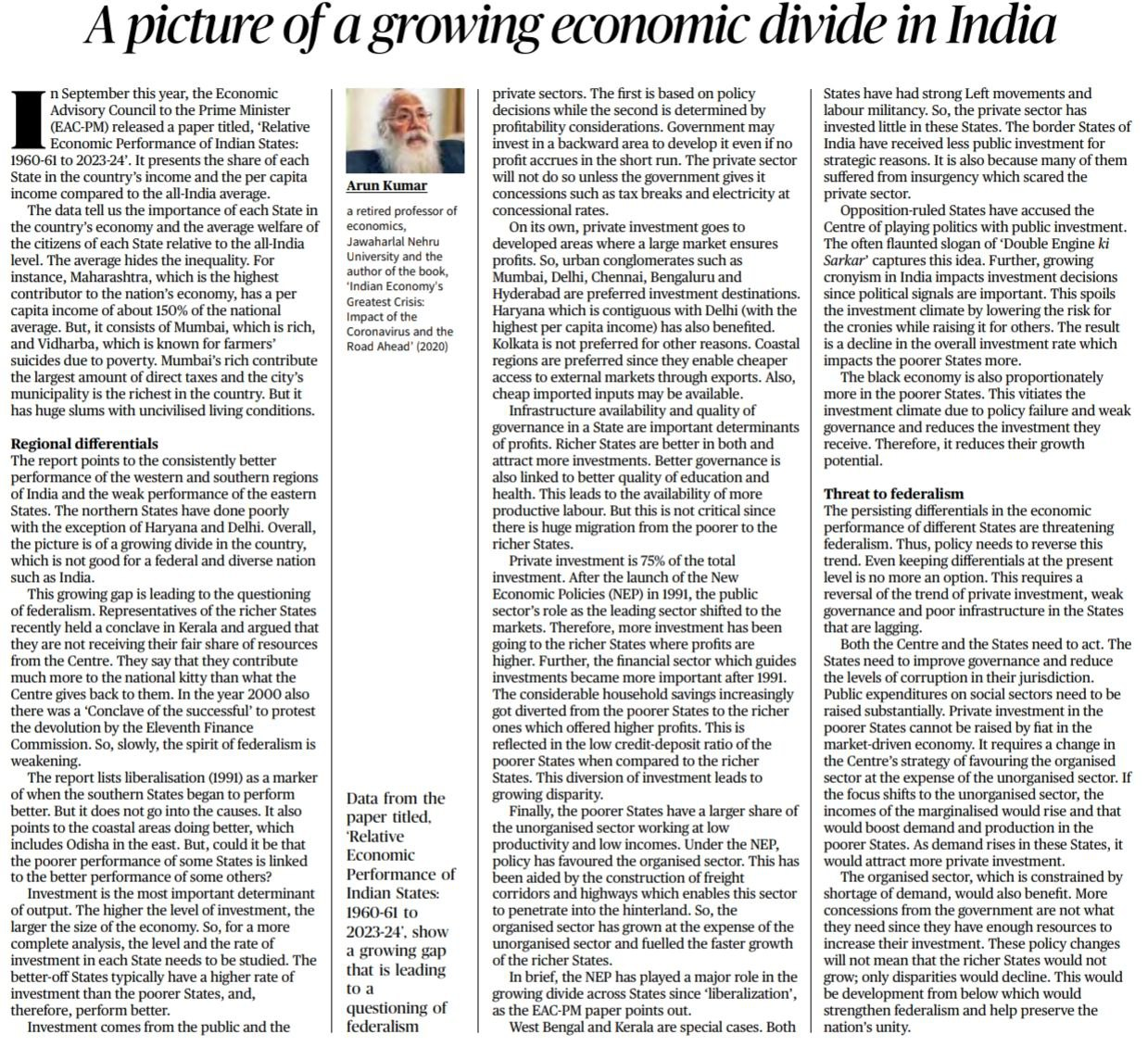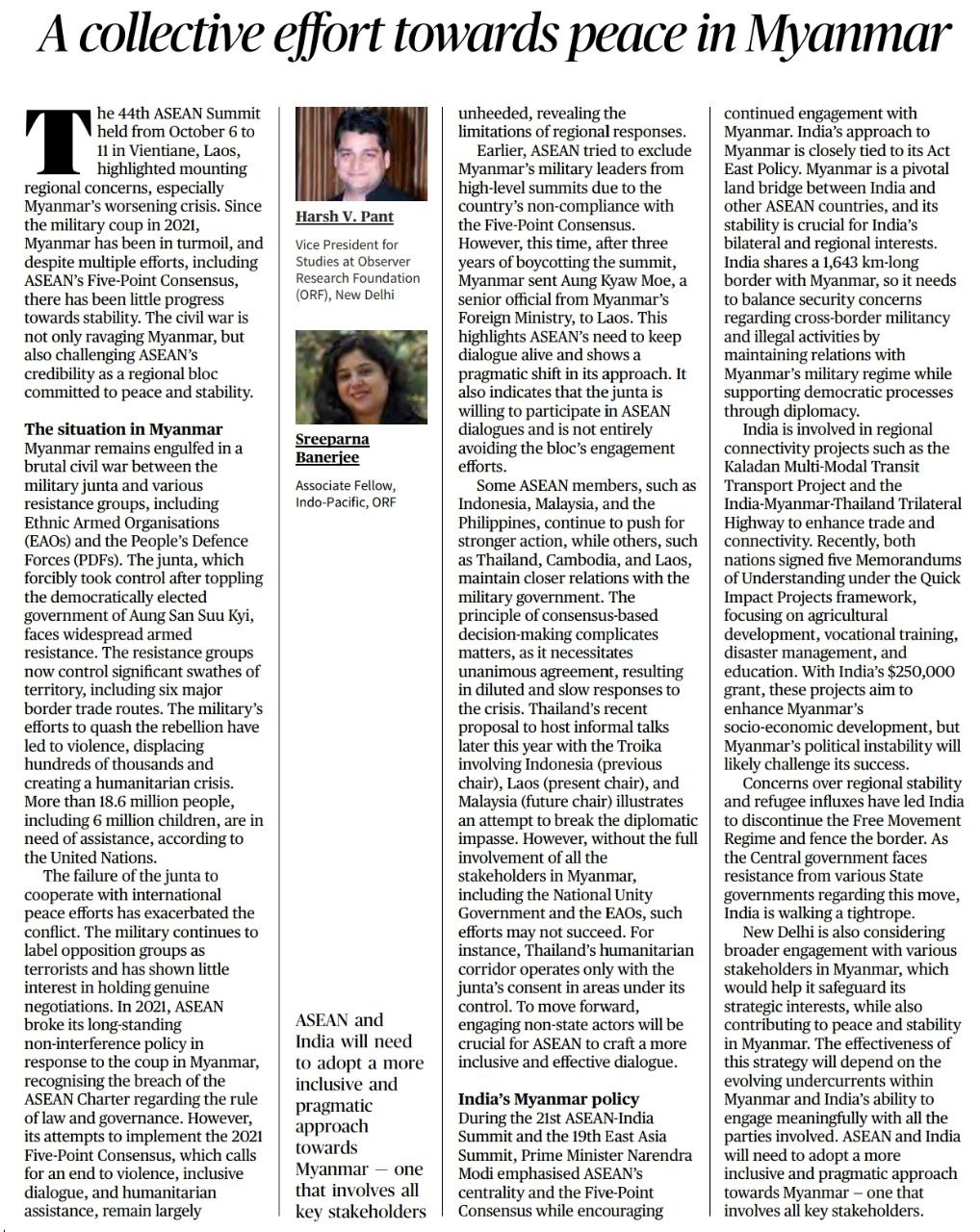1. Economic Disparity and Federalism in India
Introduction
- The Economic Advisory Council to the Prime Minister (EAC-PM) released a report titled, Relative Economic Performance of Indian States: 1960-61 to 2023-24, highlighting disparities in per capita income across Indian states.
- The report reveals significant inequality, with certain states consistently contributing more to the national economy, creating a growing divide between regions.
- This economic disparity has raised concerns about federalism, as richer states question the fairness of resource allocation from the central government.
- Regional Economic Disparities
- Northern states, excluding a few, generally perform poorly compared to the western and southern states.
- Wealthier states like Maharashtra, Karnataka, and Gujarat exhibit high per capita income due to industrial growth and urbanization.
- Poorer states often depend on the coastal and resource-rich regions for their economic stability.
- Factors Contributing to Disparities
- Investment Patterns:
- Private investment, which constitutes 75% of the total investment, favors urban and industrialized states due to profitability.
- Infrastructure availability, better governance, and policies like tax breaks attract more private investments in richer states.
- Policy Biases:
- The New Economic Policies (NEP) of 1991 prioritized private sector growth, inadvertently benefiting richer states.
- Government subsidies for backward areas fail to match the growth enabled by private investments in wealthier regions.
- Migration and Employment:
- Economic opportunities drive migration from poorer to richer states, exacerbating the labor shortage and low productivity in economically weaker regions.
- Investment Patterns:
- Impact on Federalism
- Wealthier states argue for a larger share of national revenue, claiming that they contribute more to the economy.
- Centralized financial policies perceived as favoring poorer states create a sense of resentment in richer states.
- Such disparities weaken the spirit of federalism, as states with greater economic power demand more autonomy and resources.
- Role of West Bengal and Kerala
- States like West Bengal and Kerala, despite historically following socialist models, face challenges in attracting private investment.
- These states rely heavily on public investment and government support, contrasting with the privatization-led growth in other states.
- Potential Threats to National Unity
- Economic disparity raises the risk of regionalism, as states feel alienated or overburdened by central financial decisions.
- Disparity-induced migration could strain social harmony and aggravate inequality, creating a potential threat to national cohesion.
Conclusion
- To bridge the economic divide, policies must focus on equitable distribution of resources and fostering growth in underperforming states.
- Promoting investment in weaker regions and ensuring fair policy interventions can strengthen federalism and ensure balanced national development.
- Addressing these disparities is crucial for maintaining unity and achieving holistic growth in India.
Mains Practice Question |
Q: “Economic disparity among Indian states poses a challenge to federalism.” Discuss the factors contributing to the economic divide and suggest measures to address this issue.
|
2. ASEAN's Efforts and India's Role in Myanmar Peace Process
Introduction
- The 44th ASEAN Summit in October 2024 highlighted ongoing regional concerns over Myanmar’s worsening civil conflict, which has been in turmoil since the 2021 military coup.
- Myanmar’s crisis presents a challenge not only to ASEAN’s credibility but also to regional stability and India’s security interests.
- Current Situation in Myanmar
- Myanmar is engulfed in a brutal civil war between the military junta and resistance groups, including Ethnic Armed Organizations (EAOs) and the People’s Defence Forces (PDFs).
- The military, which overthrew the democratically elected government, faces significant opposition and controls only certain urban areas and trade routes.
- The conflict has created a severe humanitarian crisis, with over 18.6 million people needing assistance, including 6 million in critical need.
- ASEAN’s Response and Challenges
- ASEAN has tried to implement the Five-Point Consensus to restore stability, calling for dialogue, humanitarian aid, and cessation of violence.
- Despite ASEAN’s efforts, including attempting to exclude Myanmar’s military leaders from summits, progress has been minimal due to the military’s non-compliance.
- The consensus-driven ASEAN structure, requiring unanimous agreement, has diluted the response to the Myanmar crisis.
- ASEAN members like Indonesia and Thailand have taken independent diplomatic measures, such as informal talks with the junta and humanitarian corridors, yet these efforts have not succeeded in breaking the deadlock.
- India’s Role and Strategic Concerns
- India’s interest in Myanmar is tied to its Act East Policy and strategic concerns, given their 1,643 km shared border and security issues like cross-border militancy.
- India is involved in key infrastructure projects, including the Kaladan Multi-Modal Transport Project and the India-Myanmar-Thailand Trilateral Highway, aimed at enhancing connectivity and socio-economic development.
- Despite regional instability, India is attempting to balance diplomatic pressure with strategic engagement, recently halting the Free Movement Regime at the border while monitoring security issues.
- The Way Forward for ASEAN and India
- ASEAN needs to adopt a more inclusive and pragmatic approach, engaging all stakeholders, including EAOs and the National Unity Government, to foster meaningful dialogue.
- India must coordinate with ASEAN to ensure that Myanmar’s stability is achieved through a multi-stakeholder peace process that includes international actors.
- Collaborative peace initiatives, combined with regional economic development projects, could help stabilize Myanmar and secure regional interests.
Conclusion
- ASEAN and India must work towards an inclusive peace framework that respects Myanmar’s sovereignty while addressing the humanitarian crisis and preventing regional spillover effects.
- The situation demands a strategic balance between diplomatic pressure and pragmatic engagement with key stakeholders for sustainable peace.
Mains Practice Question |
Q: “ASEAN and India face a complex challenge in addressing Myanmar’s crisis.” Analyze the regional implications of the Myanmar conflict and suggest a collaborative framework for ASEAN and India to promote peace and stability. |



